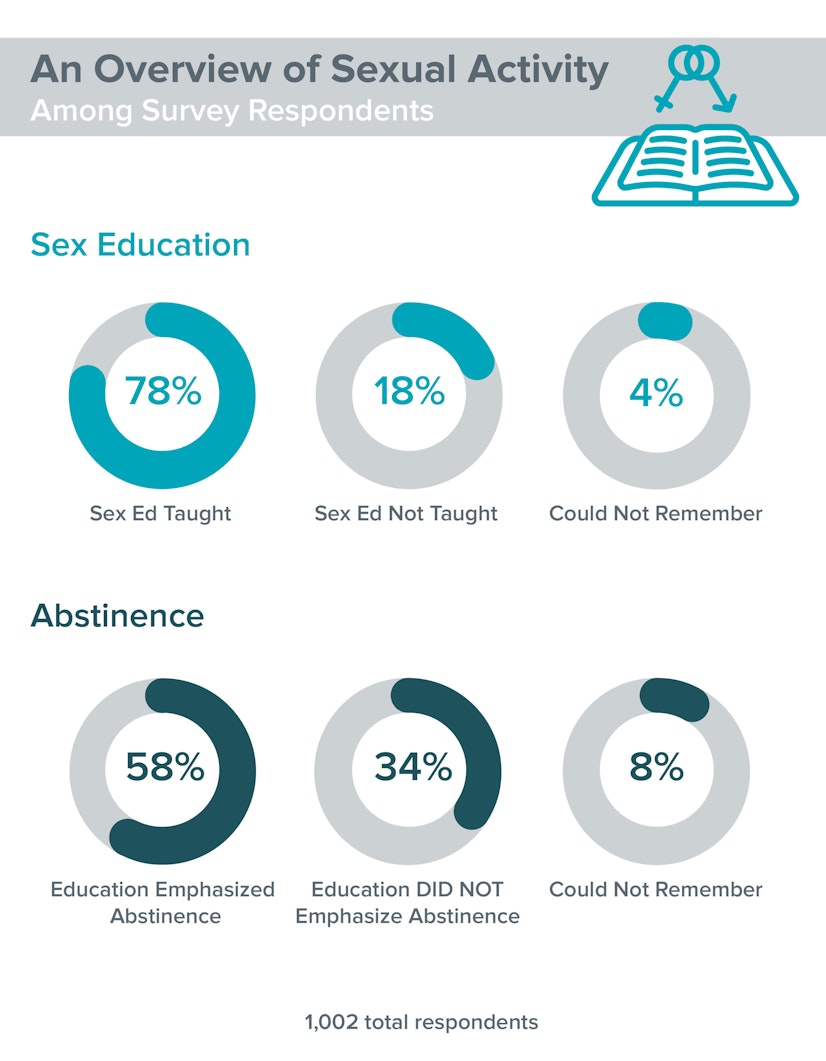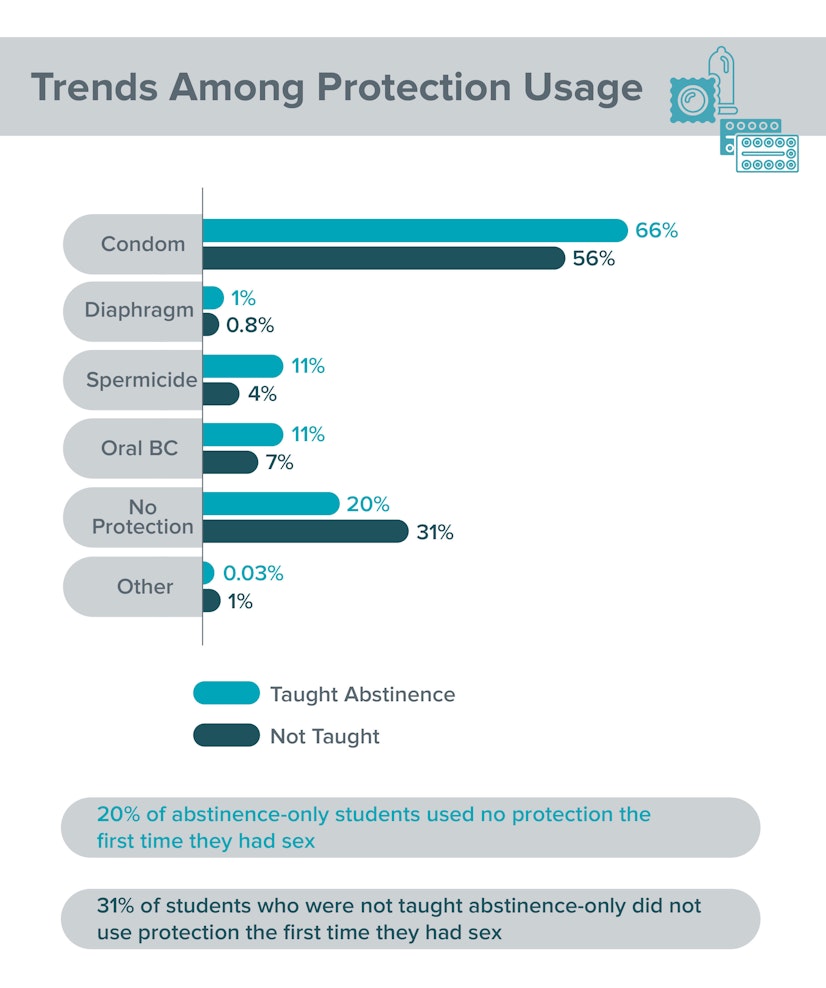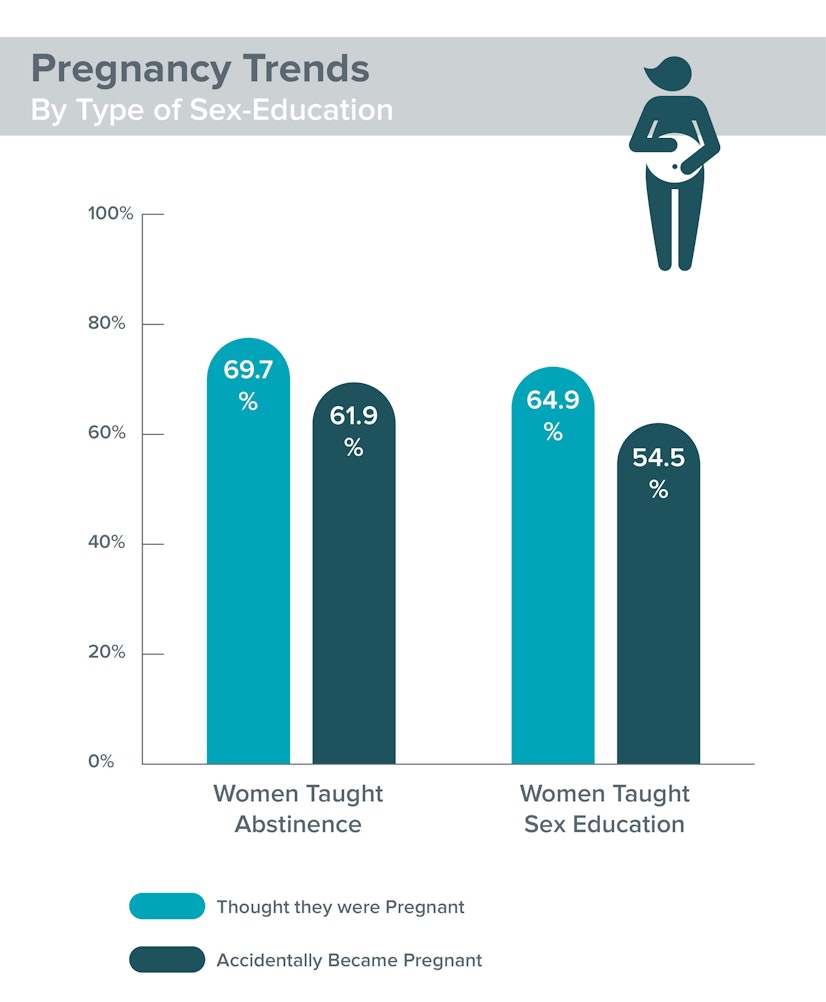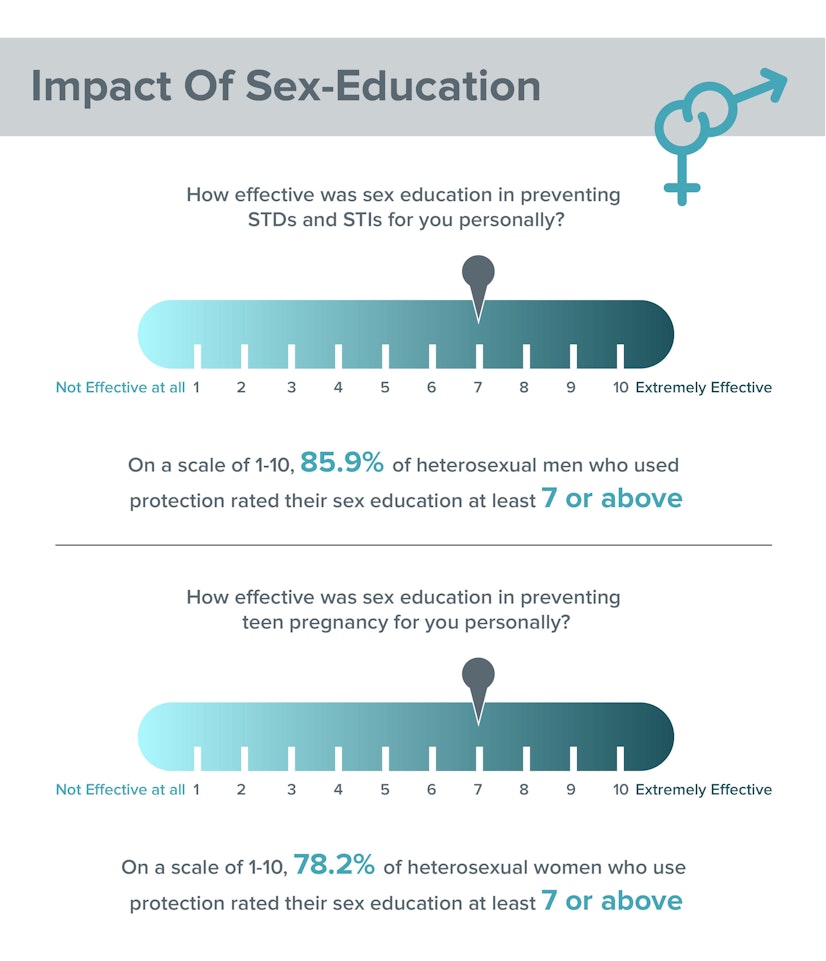Abstinence vs. Sex Education: Which one is 'better'?
According to our survey, abstinence-only sexual education increases the risk of unplanned pregnancy and STD/STI exposure.

Abstinence, the practice of restraining yourself from something that gives pleasure, such as sexual activity, has been taught in some schools as a way to prevent pregnancy and STDs. On the other hand, sex education programs offer students instruction on the anatomy and physiology of sexual activity and health, often teaching different forms of protection to prevent STDs and unwanted pregnancies.
Which education method is “better”? How do typical, everyday Americans view one versus the other?
We surveyed 1,002 men and women about their perceptions of abstinence vs. sex education, including how their respective education affects their current sexual lifestyle and practices. Let’s take a look at the results.
Jump to:
Key takeaways
- 78.9% of people taught sex ed in school used some form of protection when they first had sexual intercourse.
- 60.9% of people exposed to abstinence education but not sex education in school used some form of protection when they first had sexual intercourse.
- On a scale of 1-10, 79.6% of people taught sex education rate the sex-ed program’s effectiveness as a seven or higher based on how impactful it was for preventing pregnancies and STDs/STIs.
- At least four out of ten sexually active people get tested for STDs/STIs once or twice a year.
- 32.1% of sexually active people have never gotten tested for STDs or STIs.
An overview of sexual activity among survey respondents

According to the survey results, most heterosexual men had sexual intercourse for the first time between the ages of 16-18, whereas most heterosexual women had intercourse for the first time between the ages of 20-22.
Out of all respondents, 78% were taught sex education in schools, and 58% had an education that emphasized abstinence. There is some overlap, with 53% of all respondents receiving both sex education and abstinence emphasis in their school curricula.
Additionally, 23.9% of all respondents did not use any type of protection the first time they had sexual intercourse. However, those given guidance through sex education on properly protecting themselves during intercourse were 1.3 times more likely to use protection than those taught abstinence-only in school.
Protection usage and trend comparisons

Safe sex and protection education
Among the survey respondents, 78.9% of those taught sex education in school used some form of protection when first having sexual intercourse, including:
- Condoms
- Oral birth control
- Spermicide
- Diaphragm
On the other hand, roughly 69% of those taught abstinence used protection their first time.
As referenced by some studies, men often do not choose to use protection (specifically condoms) due to:
- The perception that condoms are not efficacious
- A general dislike of the sensation
- An image of condoms as effeminate
Despite this, according to our survey results, six out of ten heterosexual men still preferred to use a condom over other forms of protection when having sexual intercourse for the first time.
If condoms are not your first choice, there are plenty of other ways to protect yourself and your partner during sexual intercourse, including:
- Oral contraceptive pills (known as birth control pills)
- An intrauterine device (IUD)
- Contraceptive implants
- Spermicide
STD prevention
Just over half of people who were taught to use protection in their sex education courses have never been diagnosed with an STD or STI. In comparison, only 42% of people taught abstinence-only have never been diagnosed with an STD or STI. Therefore, those taught about different forms of protection and how to use them were less likely to be diagnosed with a sexually transmitted disease than those taught abstinence.
By providing information to the youth about reproductive health and encouraging the consistent use of contraception or STD protection, the risks of sexually transmitted infections and diseases can decrease, along with the chances of unwanted pregnancies. Sex education, especially regarding protection, can allow for safer sexual practices. In fact, certain studies show that formal sex education programs among young adults help increase knowledge and awareness of reproductive health overall.
Pregnancy trends by type of sex education

Pregnancy scares and accidental pregnancies
Among the heterosexual female survey respondents taught abstinence in school, 69.7% thought they were pregnant at one point, and 61.9% became pregnant accidentally. In comparison, 64.9% of heterosexual female respondents taught sex education in school thought they were pregnant at one point, and 54.5% had accidental pregnancies.
As a result, women taught abstinence as the only form of contraception were more likely to have a pregnancy scare and have an accidental pregnancy compared to women taught about other forms of protection through sex education.
Abstinence and sexual partners
Respondents from abstinence-only curricula averaged approximately 4-5 sexual partners, while those taught sex education averaged six sexual partners.
We also found that 55.4% of those from abstinence-only programs were diagnosed with an STD or STI at some point. Only 45% of sex-educated respondents have ever been diagnosed with an STD or STI.
Some abstinence teachings helped to reduce the number of sexual partners per person compared to those who were sex-educated. However, abstinence-only education also reduced STD/STI protection, ultimately increasing the amount of sexually-transmitted diseases among the abstinent. Abstinence is considered 100% effective at preventing the spread of STDs and STIs and protecting from unwanted pregnancies. However, these survey results show that a lack of education about contraception has the opposite effect.
Why are so many abstinence-taught individuals still getting STDs? According to the Mailman School of Public Health at Columbia University, abstinence-only education is a failure. While abstinence is theoretically effective, in actual practice, people often do not follow through with their intentions to fully abstain from sexual activity. As a result, these abstinence programs do not prepare and educate young adults about the threats and possibilities of unwanted pregnancies and STDs/STIs.
Impact of sex education

In this survey, we asked those taught sex education to rate the effectiveness of sex education in preventing STDs/STIs based on their personal judgments. On a scale of 1-10 (1 = not effective at all; 10 = highly effective), we found that 85.9% of heterosexual men who use protection rated their sex education at least a seven or above. Additionally, regarding effectiveness at preventing teen pregnancies, 78.2% of heterosexual women who use protection rated their sex education at least a seven or above.
Not only does sex education cover the anatomical backgrounds of the male and female reproductive systems, but some programs cover topics such as how to properly use protection, which can help prevent unwanted pregnancies and shield all parties from sexually transmitted diseases.
Methodology
We surveyed 1,002 men and women about their sexual health education, comparing that information to their current sexual lifestyle. We wanted to dig deeper into the relationships between abstinence and sex education and STD/STI testing, use of protection, and unplanned pregnancy prevention.
Fair use statement
Innerbody Research is committed to providing objective, science-based suggestions and research to help our readers make more informed decisions regarding health and wellness. We invested the time and effort into creating this report and other STD-related guides to raise awareness for STD prevention and teen pregnancy. We hope to reach as many people as possible by making this information widely available. As such, please feel free to share our content for educational, editorial, or discussion purposes. We only ask that you link back to this page and credit the author as Innerbody.com.
References
9 types of contraception you can use to prevent pregnancy (with pictures!). (2019, October 9). Queensland Health. Retrieved July 8, 2022, from https://www.health.qld.gov.au/news-events/news/types-contraception-women-condoms-pill-iud-ring-implant-injection-diaphragm.
Abstinence-only education is a failure. Mailman school of public health. (2017, August 22). Retrieved July 8, 2022, from https://www.publichealth.columbia.edu/public-health-now/news/abstinence-only-education-failure.
Barnett B. (1997). Education protects health, delays sex. Network (Research Triangle Park, N.C.), 17(3), 14–20. Retrieved July 8, 2022, from https://pubmed.ncbi.nlm.nih.gov/12292388.
Farrington, E. M., Bell, D. C., & DiBacco, A. E. (2016). Reasons people give for using (or not using) condoms. AIDS and behavior, 20(12), 2850–2862. Retrieved July 8, 2022, from https://www.ncbi.nlm.nih.gov/pmc/articles/PMC5720389/.
What is the effectiveness of abstinence and outercourse? Planned Parenthood. (n.d.). Retrieved July 8, 2022, from https://www.plannedparenthood.org/learn/birth-control/abstinence-and-outercourse/how-effective-are-abstinence-and-outercourse.


